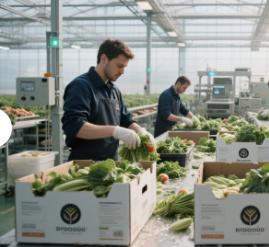Smart Greenhouse Applications in the Middle East and Africa: Case Studies and Success Stories
In the arid and semi-arid regions of the Middle East and Africa, where water is scarce and temperatures soar, traditional agriculture faces significant challenges. However, smart greenhouses are emerging as a beacon of hope, enabling farmers to grow crops year-round despite harsh conditions. For instance, in the United Arab Emirates, a country known for its extreme heat and limited arable land, smart greenhouses have been implemented with remarkable success. These greenhouses use advanced technologies like hydroponics and aeroponics, which significantly reduce water usage compared to traditional farming methods. In Morocco, another success story, smart greenhouses equipped with solar-powered irrigation systems have allowed farmers to cultivate vegetables and fruits in areas previously deemed unsuitable for agriculture. These case studies highlight how smart greenhouses can transform agriculture in regions with extreme climates.

How Smart Greenhouse Technology Addresses Drought, High Temperatures, and Water Scarcity
Smart greenhouses are specifically designed to tackle the challenges of drought, high temperatures, and water scarcity. They employ a range of technologies to optimize resource use and create a controlled environment conducive to plant growth. For example, advanced irrigation systems in smart greenhouses use sensors to monitor soil moisture levels, ensuring that water is delivered only when and where it is needed. This precision irrigation can reduce water usage by up to 90% compared to traditional methods. Additionally, smart greenhouses often incorporate cooling systems that use evaporative cooling or shading to maintain optimal temperatures, even in the hottest climates. These technologies not only conserve water but also create a stable environment for crops, leading to higher yields and better quality produce.
Smart Greenhouses' Contribution to Food Security and Sustainable Agriculture
The role of smart greenhouses in enhancing food security and promoting sustainable agriculture cannot be overstated. By enabling year-round crop production in regions with extreme climates, smart greenhouses help to stabilize food supplies and reduce dependency on imports. In areas where traditional farming is not feasible due to water scarcity or high temperatures, smart greenhouses provide a viable alternative. They also contribute to sustainable agriculture by reducing the need for chemical fertilizers and pesticides. The controlled environment of smart greenhouses allows for precise nutrient delivery and pest management, minimizing the environmental impact of farming. Furthermore, the efficient use of resources like water and energy in smart greenhouses aligns with the principles of sustainable agriculture, making them a crucial tool in the fight against climate change and resource depletion.
Future Trends in Smart Greenhouses: Technological Innovations and Market Potential
The future of smart greenhouses looks promising, with ongoing technological innovations and growing market potential. Advances in automation and artificial intelligence are making smart greenhouses even more efficient and user-friendly. For example, AI-driven systems can analyze data from sensors in real-time, providing farmers with actionable insights and automating routine tasks. This not only saves time and labor but also enhances decision-making. Additionally, the integration of renewable energy sources like solar and wind power is becoming more common, reducing the carbon footprint of smart greenhouses. The market for smart greenhouses is also expanding, driven by increasing demand for sustainable and efficient agricultural solutions. As awareness of the benefits of smart greenhouses grows, more farmers and investors are turning to this technology to meet the challenges of modern agriculture.
Conclusion
Smart greenhouses are proving to be a game-changer in regions with extreme climates and resource scarcity. By leveraging advanced technologies to optimize resource use and create controlled growing environments, smart greenhouses are helping to address the pressing challenges of drought, high temperatures, and water scarcity. They are also making significant contributions to food security and sustainable agriculture. With ongoing technological innovations and growing market potential, the future of smart greenhouses looks bright. As we continue to face the challenges of climate change and resource depletion, smart greenhouses offer a promising solution for sustainable and efficient food production.
Welcome to have a further discussion with us.
Phone: +86 15308222514
Email: Rita@cfgreenhouse.com
Post time: Jul-03-2025







 Click to Chat
Click to Chat